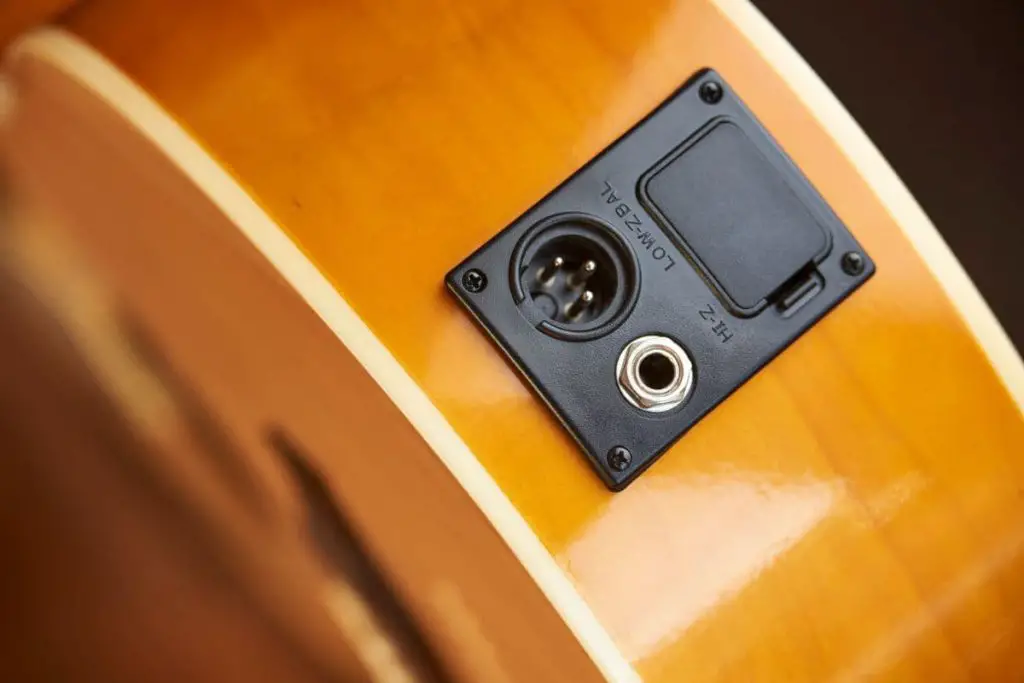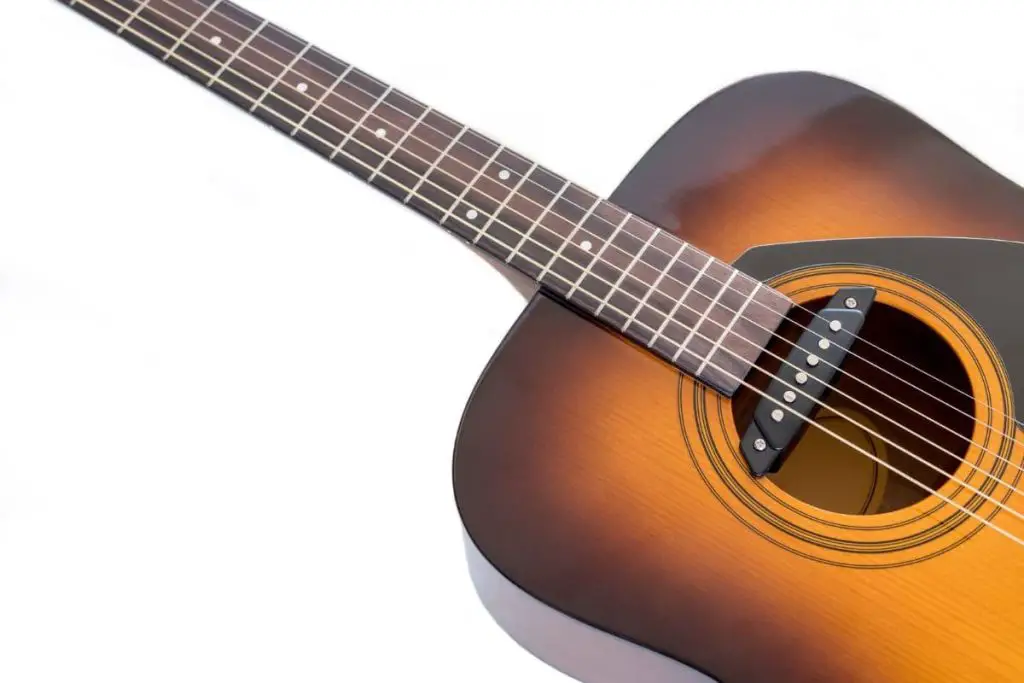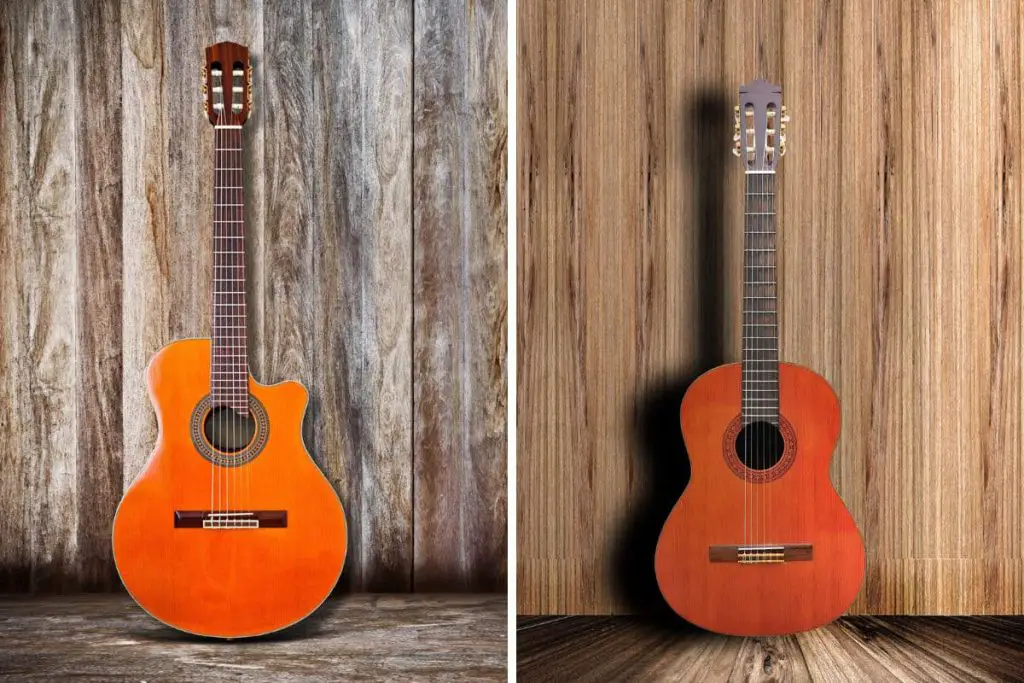You’ve probably noticed that most of them need batteries if you’re in the market for an acoustic-electric guitar. This addition might seem unusual because regular electric guitars typically don’t include batteries. However, the reasoning behind this is a bit more complex, and we have to give a nuanced answer.
Acoustic-electric guitars need batteries to power their preamps. Most of them don’t produce strong enough signals to be sent to the amplifier, so those signals must be preamplified. Preamplifiers can’t work independently, so they rely on batteries to get enough power.
Read on if you’re keen on learning more about acoustic-electric guitars and why most of them require batteries. We’ll explain how their pickups work in detail and why those pickups mostly need batteries.
👇😀👇NOTE👇😀👇
If you want to find out what my recommended guitar gear is, then here is what I recommend on Amazon:
- Fender Cutaway Acoustic-Electric Guitar Bundle (MY FAVORITE GUITAR)
- Snark SN-8 Super Tight All Instrument Tuner (Easiest Tuner I’ve Used😏)
- 6 String Acoustic Guitar Capo (Best CAPO for quick changes)
- Dunlop Max Grip 1.0mm Nylon Picks (Thick Guitar Pick So You Don’t Lose Grip!)
- Universal Guitar Stand (Cheap & Minimalist Guitar Stand I Recommend)
- Levy’s 2″ Wide Quick Adjust Guitar Strap (Best Guitar Strap For Any Level)

Acoustic Guitars and Batteries
Acoustic electric guitars rely on batteries to produce proper sound—It all boils down to signal strength and preamplification.
Most acoustic guitar magnets require batteries to work because they produce weak signals. Magnets that have weak signals require preamps. Preamps don’t make power on their own, so they need an external source of electricity. Batteries do this job.
The only exception to this rule is passive soundhole pickups. Passive pickups don’t require batteries to work. Unfortunately, most acoustic-electric guitars won’t have such a pickup, so you’ll have to use batteries if you want to use the electric capabilities of your acoustic electric guitar.
Microphone pickups are small diaphragm microphones. Microphones produce weak signals that must be preamplified before your amp can process them. Therefore, if your acoustic-electric guitar has a microphone pickup, you’ll need a battery to power it.
Piezo pickups also require preamps to work efficiently, and thus, batteries. Since most acoustic-electric guitars have piezo pickups, most acoustic-electric guitars also need batteries to operate. That is, their preamps need batteries.
What Type of Batteries Do Acoustic-Electric Guitars Need?
Most acoustic-electric guitars use nine-volt batteries. These are the standard batteries you might find in transistor radios or smoke alarms. Some guitars also use AA batteries. No matter which batteries you need, you can easily find them in any store, so there’s no need to order online or go to a specialized store.
Nine-volt batteries can last up to 40 hours if you use them as intended. Some manufacturers claim that their batteries can last up to 100 hours, but it’s questionable whether this is true. You can expect half as much from AA batteries.
You can increase your battery life if you turn off unused features and unplug your guitar after playing. Leaving it plugged in will drain the battery. Don’t let yourself return to your guitar after a sound check only to find that your battery drained and your guitar is unusable for the gig.
It’s also a good idea to always carry a spare pack of batteries. While you might not need them, you can never be too sure, so it’s best to be on the safe side.
Will Your Acoustic Electric Guitar Work Without Batteries?
Since acoustic-electric guitars generally rely on batteries for amplification, you might be worried that your guitar won’t work if there are no batteries. It will work, but only to a certain extent. The preamp won’t work without batteries, so there will be no way to amplify the guitar’s sound.

This issue won’t allow you to play live shows, which is probably the main reason why you have an acoustic-electric guitar in the first place.
On the other hand, your guitar will make an acoustic sound just fine even without batteries. Since this doesn’t rely on preamplification, you’ll be able to play just fine. However, you’ll be much quieter than you need, so you’ll be unable to play live shows this way.
Acoustic Guitar Pickups
Acoustic guitars can be a bit tricky to amplify. Before guitar makers invented acoustic-electric guitars, the only way to amplify an acoustic guitar was to put it directly in front of a microphone. This method is still often used in studios but can be a real pain in the neck when you’re trying to play live.
When you mic an acoustic guitar, you’re not allowed to move. Even a slight movement away from the guitar may drastically reduce the volume. You’ll find that standing in place while trying to perform naturally is no fun.
Another disadvantage is that the microphone will pick up the sounds of the other instruments so that you may end up with a muddy sound and unintelligible noise. This setup will also generate a lot of feedback—so the overall sound will be unbearable.
This problem was solved when people figured out they could install pickups on their acoustic guitars. This addition allowed guitarists to get good sound quality and move around—a win-win situation for musicians and their audiences.
Soundhole Pickups
Soundhole pickups are a great option to convert a regular acoustic guitar into an acoustic-electric. As the name suggests, musicians mount these pickups across the soundhole, usually toward the neck.
These pickups work much like electric guitar pickups. They consist of magnets and a wire coiled around them. When you pluck a string, its vibration disturbs the magnetic field of the pickups, creating an electric signal transferred via a cable to your amplifier, and thus, you get a sound.

Just like electric guitar pickups, they can be both active and passive.
This option is a very convenient way to amplify your acoustic guitar, and you’ll get a decent tone. It will sound relatively warm, and you’ll get a lot of clarity from each string. These pickups also work well with effects, so you can add a bit of reverb or get super creative with your sound.
A significant drawback of soundhole pickups is that they don’t capture all the details of an acoustic guitar’s sound. Such pickups work well on electric guitars because their sound is entirely electric and doesn’t rely on the resonance of the guitar’s body.
An acoustic guitar’s sound doesn’t only come from the strings’ vibrations. The body of the guitar dramatically influences the sound. A soundhole pickup can’t capture this, so you won’t get a pure acoustic guitar sound with one, but rather a sound that resembles an electric guitar.
Microphone Pickups
A microphone pickup is a great way to mic up your acoustic guitar while avoiding all the downsides of using a regular microphone. This method is a great way to amplify the natural sound of an acoustic guitar with minimal changes to the sound.
Unlike a soundhole pickup, a microphone pickup will capture the natural overtones of your acoustic guitar and the beauty of the resonance of its body. You’ll get a clear sound that sounds warm and un-electrified.
There are two types of microphone pickups, which are as follows:
Internal Pickups
Internal pickups will give you an incredible sound, but at a very steep price. They’re also quite challenging to install, and the installation process requires a bit of experimentation to find the correct position. It’s best not to do this alone, which means the price will become even steeper when you add installation costs to the pickup’s cost.
External Pickups
External microphone pickups are usually relatively cheap, and you can get one for a few dollars. Of course, you shouldn’t pick the cheapest one, but even if you get the most expensive one, you’ll pay less than for an internal microphone pickup.
External microphone pickups are often clip-on, which makes them super easy to install. However, this might make the guitar look less aesthetically pleasing, and the pickup might get in the way, which might not make it the best choice. Their sound quality is also not as good as the one you’d get from an internal microphone pickup.
Regardless of their position in the guitar, microphone pickups produce weak signals that must be preamplified.
Piezo Pickups
Piezo pickups, also known as transducer pickups, are the most common pickups on acoustic-electric guitars. This technology is older than electromagnetic pickups and functions drastically differently.
Musicians typically mount piezo pickups beneath the saddle, and unlike electromagnetic pickups, they don’t pick up the strings’ vibrations. Instead, they rely on a compressed crystal to detect changes in the pressure caused by the vibrations. This pressure generates an electric signal, which travels to your amplifier.
These pickups are great for playing loudly and are less susceptible to feedback. They’re also an excellent choice for amplifying classical guitars, as they don’t rely on the magnetism of metal strings to produce sounds.
However, their sound can be brittle and percussive to many guitarists. So whether you opt for these pickups boils down to personal preference, though, and you might find that you enjoy the sound of these pickups.
They also produce a relatively weak signal that must be preamplified before it gets to your amp.
There are also combinations of different types of pickups. For example, some guitarists like to have a microphone and piezo pickup on their guitar to pick the best from both worlds. However, we’ll stick to the three main types for simplicity.
Why Don’t Electric Guitars Have Batteries?
You’ve probably noticed that electric guitarists rarely talk about batteries. This omission might imply that electric guitars never have batteries and don’t need them. However, it’s a bit more complex.

Whether or not electric guitars have batteries also depends on what type of pickups they have. Passive pickups don’t require batteries, while active pickups do. Most guitars have passive pickups, which is why you rarely hear guitarists mentioning batteries. Most guitarists you know likely have guitars with passive pickups.
Let’s examine these pickups more closely and see why they may or may not need pickups.
Passive Pickups
Passive pickups rely solely on their magnetism to create a sound. They don’t require any additional input of electricity to function. If you plug a guitar with passive pickups into an amp, it’ll get all the electricity it needs.
Passive pickups offer several advantages:
- Cost-effective. Passive pickups are a bit cheaper than their active counterparts. They have a very familiar sound (precisely because they’re the majority of pickups), so they sound more natural and organic to most people.
- Passive pickups are responsive. These pickups are also very responsive and sensitive, which makes them a versatile tool you can use in many different genres of music. They can do a great job in soft pop and heavy metal, as long as you know how to deal with them.
- They’re simpler to use. You don’t have to worry about getting batteries, changing them, and wondering if your battery is okay in the middle of the gig. You’ll never run into an awkward situation where your guitar dies in the middle of a shoe-melting solo.
The most significant disadvantage is that they are prone to noise. Single-coil pickups are particularly prone to humming, which can be mind-blowingly annoying. They also offer less control over the sound and can sound muddy, at least in comparison with active pickups.
Active Pickups
Active pickups work similarly to passive pickups. An active pickup has a passive one in its core but has fewer coils and thus produces a weaker signal. This weak signal has to be preamped before use.
Since it has to be preamped, there has to be some active circuitry that requires an external power source to function. That’s the reason why active pickups need batteries to work correctly.
It might seem like they are inferior to passive pickups in this regard, but they have some key advantages that make them popular among some circles of guitarists:
- Active pickups are quiet. The main advantage of active pickups is that they are quiet. In other words, they don’t produce humming, buzzing, or any other noise. This lack of distortion is a considerable advantage if you frequently run into this problem.
- They work well with heavier tones. This advantage is why you often find them in heavier metal subgenres. Their low-end sounds excellent, but their high-end is also very clear, so they are versatile. They also work great with pedals, so they provide multiple uses.
- They function well with no loss of high sounds when you use a long cable with them. This feature makes them particularly suitable for live concerts on bigger stages where you can’t get away with using only a few feet of cable.
The most significant disadvantage to these pickups is that they’re more challenging to use. You have to worry about more things and ensure your batteries won’t die in the middle of the gig. There are also screws you have to deal with when changing batteries, which means that there’s always a risk of losing one or two, which can be a frustrating experience.
As the batteries come to the end of their life, your tone will lose a lot of quality. Even before this happens, you might find that a guitar with active pickups sounds less natural than a guitar with passive pickups. This option is a matter of personal preference, though, and it might just be because you hear guitars with passive pickups much more often, so you’re used to that sound.
Active vs. Passive Pickups: Which Option Is Better?
It’s impossible to say which one is better with certainty. It depends solely on your needs, preferences, and mood.
Getting one with active pickups is a good choice if you want a guitar that doesn’t make much noise. It’s even better if you want to play heavy music with lots of control over your tone and sound.
On the other hand, if you want a sound you’re familiar with and sounds more natural, passive pickups are the best choice. They’re also a great choice if you want something simple to use, giving you fewer reasons to worry. I’d say that most guitarists fall into this category.
Is an Electric Acoustic Guitar Better than an Acoustic Guitar?
An electric acoustic guitar is better than an acoustic guitar because it has a built-in pickup system you can plug straight into an amp or mixing console. These guitars deliver a reliable tonal output giving musicians greater control in live gigs and allowing musicians to move freely onstage.

Other advantages of acoustic electric guitars include the following:
- More control over the sound. Musicians using electric acoustic guitars have greater control of the guitar’s pickup output when playing at high volumes.
- More practical for live play. Players of these instruments also save time by not having to tweak the suns of different mikes when they are touring several venues.
- Less bleed from other acoustic sources. The in-built pickup system of the acoustic electric guitar reduces the leakage of other audio sources’ output while performing.
Final Thoughts
Acoustic-electric guitars generally have batteries because they include preamps. Preamps can’t work on their own; they need an external source of power. The batteries are there to act as a power source.
Acoustic-electric guitars can work without batteries, but you will not be able to amplify your sound without them. That’s why you always need to have spare batteries and make sure that there’s a full battery in your guitar. Otherwise, you might be caught off guard and unable to play a gig.
👇😀👇NOTE👇😀👇
If you want to find out what my recommended guitar gear is, then here is what I recommend on Amazon:
- Fender Cutaway Acoustic-Electric Guitar Bundle (MY FAVORITE GUITAR)
- Snark SN-8 Super Tight All Instrument Tuner (Easiest Tuner I’ve Used😏)
- 6 String Acoustic Guitar Capo (Best CAPO for quick changes)
- Dunlop Max Grip 1.0mm Nylon Picks (Thick Guitar Pick So You Don’t Lose Grip!)
- Universal Guitar Stand (Cheap & Minimalist Guitar Stand I Recommend)
- Levy’s 2″ Wide Quick Adjust Guitar Strap (Best Guitar Strap For Any Level)
Related Posts:
